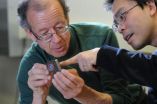(Press-News.org) WEST CHESTER, Pa., February 28, 2013 – Animas Corporation announced today positive results from the second phase of human clinical trials of a first-generation, closed-loop insulin delivery system in development, designed to predict a rise or fall in blood glucose and correspondingly increase, decrease, suspend and resume insulin delivery. The data were presented at the Advanced Technologies & Treatments for Diabetes (ATTD) Conference in Paris, France.
The feasibility study of the predictive Hypoglycemia-Hyperglycemia Minimizer (HHM) System* in development was conducted in 20 adults with Type 1 diabetes and designed to investigate the System's ability to adjust insulin dosing to proactively mitigate hypoglycemia and hyperglycemia. The study, which was the first conducted in humans to investigate the configuration of the predictive algorithm, revealed differences in the algorithm's insulin-dosing characteristics and provided insights into the sensitivity of the System. The results also indicated that the System reduced insulin delivery in advance of hypoglycemia and triggered timely warnings. The study was conducted by Animas Corporation in partnership with leading academic research institutions, including the University of California, Santa Barbara; Sansum Diabetes Research Institute; and the Center for Diabetes Technology at the University of Virginia.
"We are encouraged by these results, which strengthen our understanding of the complex algorithms required of a closed-loop insulin delivery system and further our confidence in this technology platform," said Ramakrishna Venugopalan, Director, Research & Development at Animas Corporation. "The scope of this study also reflects our commitment to create innovative and robust solutions for people living with diabetes."
Animas began collaborating with industry, academia and advocacy organizations, including the JDRF (formerly the Juvenile Diabetes Research Foundation), in 2010. After receiving Investigational Device Exemption (IDE) approval from the U.S. Food and Drug Administration (FDA) in 2011, researchers began the first human clinical feasibility studies for the development of a closed-loop insulin delivery system. Together with these key partners, Animas continues to work toward developing such an automated system to help people living with Type 1 diabetes better control their disease.
"We are encouraged by the results and progress Animas has made in the first stage of development of a closed-loop insulin delivery system," said Aaron Kowalski, Ph.D., Vice President of Treatment Therapies Research at JDRF. "A predictive system that cannot only detect, but can predict blood sugar levels and make automatic adjustments to insulin delivery would be a major advance for people with Type 1 diabetes."
* The HHM System includes a continuous subcutaneous insulin infusion pump, a continuous glucose monitor (CGM) and a control algorithm used to predict changes in blood glucose.
About the Clinical Study
The study investigated the effect of a fundamental algorithm parameter on the quantitative insulin-dosing characteristics of the System. The parameter, known as the "aggressiveness factor," affects how readily the algorithm adjusts insulin delivery in response to glucose fluctuations. This is the first study in humans to investigate tuning such an algorithm parameter. The results demonstrated differences in the algorithm's insulin-dosing characteristics based on three aggressiveness factors and reinforced the importance of investigating the sensitivity of the System to its key parameters.
The study also investigated the predictive, proactive methods by which the System mitigates hypoglycemia, especially as compared to reactive, threshold-based systems. In particular, two predictive hypoglycemia safeguards of the System were investigated: its ability to decrease/suspend insulin delivery before a hypoglycemic threshold is reached, and its ability to trigger timely alerts for imminent hypoglycemia. The results indicated that the System reduced insulin delivery in advance of breaches of a hypoglycemic threshold and triggered timely warnings for imminent hypoglycemica.
Regarding general glucose control, the System demonstrated promising results, keeping glucose levels at an average of 133 mg/dL for the entire cohort. On average, 82.8 percent of the closed-loop time was spent at glucose levels between 70-180 mg/dL, and little time (3.4 percent) was spent at levels below 70 mg/dL. There were no safety concerns, including diabetic ketoacidosis or severe hypoglycemia.
###
About Animas Corporation
As part of the Johnson & Johnson Family of Companies, Animas is dedicated to creating a world without limits for people with diabetes through a wide range of products, including the OneTouch® Ping® Glucose Management System, Animas® Vibe™ insulin pump and CGM system and the Animas® 2020 insulin pump. Animas, from the Latin word meaning "true inner self or soul," has been committed since 1996 to meeting individual patient needs through the development of life-performance technology and customer service 24 hours a day, 7 days a week, 365 days a year. To learn more about Animas, visit http://www.animas.com/.
Animas' development of a first-generation closed loop insulin delivery system progresses
Predictive glucose control system in development shows promising ability to minimize number, duration and severity of hypoglycemic events with no safety concerns
2013-02-28
ELSE PRESS RELEASES FROM THIS DATE:
The birth of a giant planet?
2013-02-28
An international team led by Sascha Quanz (ETH Zurich, Switzerland) has studied the disc of gas and dust that surrounds the young star HD 100546, a relatively nearby neighbour located 335 light-years from Earth. They were surprised to find what seems to be a planet in the process of being formed, still embedded in the disc of material around the young star. The candidate planet would be a gas giant similar to Jupiter.
"So far, planet formation has mostly been a topic tackled by computer simulations," says Sascha Quanz. "If our discovery is indeed a forming planet, then ...
Secondary facelift achieves good results, reports plastic and reconstructive surgery
2013-02-28
Philadelphia, Pa. (February 28, 2013) – Performed an average of a decade after initial facelift surgery, a "secondary" facelift can achieve similarly lasting results with a low complication rate, according to a paper in the March issue of Plastic and Reconstructive Surgery®, the official medical journal of the American Society of Plastic Surgeons (ASPS).
Dr. Rod J. Rohrich and colleagues of University of Southwestern Medical Center, Dallas, report their 20-year experience with secondary facelift surgery, or "rhytidectomy." The researchers conclude that, with attention ...
Round or 'shaped,' implants yield good results in breast reconstruction
2013-02-28
Philadelphia, Pa. (February 28, 2013) –For women undergoing breast reconstruction using implants, most patient-reported outcomes are similar with two different shapes of silicone gel-filled implants, reports a study in the March issue of Plastic and Reconstructive Surgery®, the official medical journal of the American Society of Plastic Surgeons (ASPS).
Assessment of key areas of quality of life after breast reconstruction shows few significant differences with conventional round implants versus newer "shaped" implants, according to the new research, led by Dr. Sheina ...
Progesterone may be why pregnant women are more vulnerable to certain infections
2013-02-28
Bethesda, MD—Women who are pregnant or using synthetic progesterone birth control injections have a conspicuous vulnerability to certain infections including malaria, Listeria, HIV, and herpes simplex virus. A new research report appearing in the March 2013 issue of the Journal of Leukocyte Biology offers strong evidence for a possible explanation: the progesterone receptor, a pregnancy hormone sensor, targets a part of the immune system responsible for protection against these and other invaders. In addition to helping explain why some women are more vulnerable to certain ...
Brown unveils novel wireless brain sensor
2013-02-28
PROVIDENCE, R.I. [Brown University] — A team of neuroengineers based at Brown University has developed a fully implantable and rechargeable wireless brain sensor capable of relaying real-time broadband signals from up to 100 neurons in freely moving subjects. Several copies of the novel low-power device, described in the Journal of Neural Engineering, have been performing well in animal models for more than year, a first in the brain-computer interface field. Brain-computer interfaces coud help people with severe paralysis control devces with their thoughts.
Arto Nurmikko, ...
Brain-to-brain interface allows transmission of tactile and motor information between rats
2013-02-28
DURHAM, N.C. -- Researchers have electronically linked the brains of pairs of rats for the first time, enabling them to communicate directly to solve simple behavioral puzzles. A further test of this work successfully linked the brains of two animals thousands of miles apart—one in Durham, N.C., and one in Natal, Brazil.
The results of these projects suggest the future potential for linking multiple brains to form what the research team is calling an "organic computer," which could allow sharing of motor and sensory information among groups of animals. The study was published ...
Replacing soybean meal in pig diets
2013-02-28
Canola, cottonseed, and sunflower products can replace soybean meal in diets fed to pigs, but they contain less protein and energy. To determine if it makes economic sense to use them, producers need to know the concentrations and digestibility of the nutrients they contain. To help them make the decision, University of Illinois researchers examined amino acid digestibility for these products.
"Soybean is by far the biggest oilseed crop in the world," said Hans Stein, professor of animal sciences. "But canola, cottonseed, and sunflowers are grown in areas where soybeans ...
After the human genome project: The human microbiome project
2013-02-28
Bethesda, MD—Earth Day may be more than a month away, but another, more personal, ecosystem has been shown to also be worth protecting—within our bodies are communities of microbes that affect the behavior of human cells hosting them. These communities, called the "microbiome," are so crucial to our health that some consider it to be a complex "second genome." Understanding the interaction of these microbes among one another and their human hosts has the potential to yield insights into numerous diseases and complex human disorders from obesity to susceptibility to infection. ...
Physical activity does not protect against in situ breast cancer
2013-02-28
A European study published in the 'Cancer Epidemiology, Biomarkers & Prevention' journal has analysed the association between physical activities and in situ or non-invasive breast cancer, or, in other words, cancer that has not yet invaded cells within or outside of the breast.
Headed by researchers from ten European countries including Spain, the work carried out under the framework of the European Prospective Investigation into Cancer and Nutrition (EPIC) concludes that physical activity has no relation with the risk of developing this type of non-invasive cancer. ...
Eating junk food while pregnant may make your child a junk food addict
2013-02-28
Bethesda, MD—Here's another reason why a healthy diet during pregnancy is critical to the future health of your children: New research published in the March 2013 issue of The FASEB Journal, suggests that pregnant mothers who consume junk food actually cause changes in the development of the opioid signaling pathway in the brains of their unborn children. This change results in the babies being less sensitive to opioids, which are released upon consumption of foods that are high in fat and sugar. In turn, these children, born with a higher "tolerance" to junk food need ...
LAST 30 PRESS RELEASES:
University of Oklahoma researcher awarded funding to pursue AI-powered material design
Exploring how the visual system recovers following injury
Support for parents with infants at pediatric check-ups leads to better reading and math skills in elementary school
Kids’ behavioral health is a growing share of family health costs
Day & night: Cancer disrupts the brain’s natural rhythm
COVID-19 vaccination significantly reduces risk to pregnant women and baby
The role of vaccination in maternal and perinatal outcomes associated with COVID-19 in pregnancy
Mayo Clinic smartwatch system helps parents shorten and defuse children's severe tantrums early
Behavioral health spending spikes to 40% of all children’s health expenditures, nearly doubling in a decade
Digital cognitive behavioral treatment for generalized anxiety disorder
Expenditures for pediatric behavioral health care over time and estimated family financial burden
Air conditioning in nursing homes and mortality during extreme heat
The Alps to lose a record number of glaciers in the next decade
What makes a good proton conductor?
New science reporting guide published for journalists in Bulgaria
New international study reveals major survival gaps among children with cancer
New science reporting guide published for journalists in Turkey
Scientists develop a smarter mRNA therapy that knows which cells to target
Neuroanatomy-informed brain–machine hybrid intelligence for robust acoustic target detection
Eight SwRI hydrogen projects funded by ENERGYWERX
The Lundquist Institute and its start-up company Vitalex Biosciences Announces Strategic Advancement of Second-Generation fungal Vaccine VXV-01 through Phase 1 Trials under $40 Million Competitive Con
Fine particles in pollution are associated with early signs of autoimmune disease
Review article | Towards a Global Ground-Based Earth Observatory (GGBEO): Leveraging existing systems and networks
Penn and UMich create world’s smallest programmable, autonomous robots
Cleveland researchers launch first major study to address ‘hidden performance killer’ in athletes
To connect across politics, try saying what you oppose
Modulating key interaction prevents virus from entering cells
Project explores barriers to NHS career progression facing international medical graduates
Jeonbuk National University researchers explore the impact of different seasonings on the flavor perception of Doenjang soup
Two Keck Medicine of USC Hospitals named Leapfrog Top Teaching Hospitals
[Press-News.org] Animas' development of a first-generation closed loop insulin delivery system progressesPredictive glucose control system in development shows promising ability to minimize number, duration and severity of hypoglycemic events with no safety concerns



